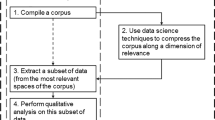Abstract
Identifying communities and analysing their dynamics in social networks is very important research problem. However, qualitative analysis (taking into account the scale of the problem) still poses serious problems. Several methods for analysis are proposed, but there is missing tool allowing visualisation of dynamics of communities and enabling performing analysis on different levels of details. This paper describes a tool enabling analysis of social group dynamics with taking into account many aspects of groups (contexts). In paper the analysis of group density, sentiment and topic modelling for groups is presented. Presented results are based on real-world data from blogosphere.





























Similar content being viewed by others
Notes
mainly focused towards politics, http://www.salon24.pl.
References
Agarwal N, Liu H (2009) Modeling and data mining in blogosphere. Synthesis lectures on data mining and knowledge discovery. Morgan and Claypool Publishers, San Rafael
Asur S, Parthasarathy S, Ucar D (2009) An event-based framework for characterizing the evolutionary behavior of interaction graphs. ACM Trans Knowl Discov Data 3(4):16
Bastert O, Matuszewski C (2001) Layered drawings of digraphs. In: Kaufmann M, Wagner D (eds) Drawing graphs. Springer, Berlin, pp 87–120
Beiro MG, Busch JR, Alvarez-Hamelin JI (2010) Visualizing communities in dynamic networks. In: LAWDN-Latin-American workshop on dynamic networks. Buenos Aires, Argentina
Blei DM, Ng AY, Jordan MI (2003) Latent dirichlet allocation. J Mach Learn Res 3:993–1022
Blondel VD, Guillaume J-L, Lambiotte R, Lefebvre E (2008) Fast unfolding of communities in large networks. J Stat Mech Theory Exp 2008(10)
Borgatti SP, Everett MG (1993) Two algorithms for computing regular equivalence. Soc Netw 15(4):361–376
Bródka P, Saganowski S, Kazienko P (2013) Ged: the method for group evolution discovery in social networks. Soc Netw Anal Min 3(1):1–14
Evans T, Lambiotte R (2009) Line graphs, link partitions and overlapping communities. Phys Rev E 80(1 Pt 2):016105
Federico P, Pfeffer J, Aigner W, Miksch S, Zenk L (2012) Visual analysis of dynamic networks using change centrality. In: 2012 IEEE/ACM international conference on advances in social networks analysis and mining (ASONAM), pp 179–183
Fortunato S (2010) Community detection in graphs. Phys Rep 486(3):75–174
Gansner ER, Koutsofios E, North SC, Vo K-P (1993) A technique for drawing directed graphs. IEEE Trans Softw Eng 19(3):214–230
Girvan M, Newman MEJ (2002) Community structure in social and biological networks. Proc Natl Acad Sci 99(12):7821–7826
Gliwa B, Kozlak J, Zygmunt A, Cetnarowicz K (2012) Models of social groups in blogosphere based on information about comment addressees and sentiments. In: 4th international conference on social informatics, SocInfo, Lausanne, Switzerland. Lecture Notes in Computer Science, vol 7710. Springer, Berlin, pp 475–488
Gliwa B, Saganowski S, Zygmunt A, Bródka P, Kazienko P, Koźlak J (2012) Identification of group changes in blogosphere. In: The 2012 international conference on advances in social network analysis and mining, ASONAM 2012. IEEE Computer Society
Gliwa B, Saganowski S, Zygmunt A, Bródka P, Kazienko P, Kozlak J (2012) Identification of group changes in blogosphere. In: IEEE/ACM international conference on advances in social networks analysis and mining, ASONAM 2012, Istanbul, Turkey
Gliwa B, Zygmunt A, Byrski A (2012) Graphical analysis of social group dynamics. In: CASoN. IEEE, pp 41–46
Gliwa B, Zygmunt A, Kozlak J (2013) Analysis of roles and groups in blogosphere. In: 8th international conference on computer recognition systems, CORES 2013, Milkow, Poland, 27–29 May 2013. Advances in intelligent and soft computing, vol 226. Springer, Berlin, pp 299–308
Greene D, Doyle D, Cunningham P (2010) Tracking the evolution of communities in dynamic social networks. In: Proceedings of the ASONAM ’10. Washington, DC, USA: IEEE Computer Society
Hanneman RA, Riddle M (2005) Introduction to social network methods. University of California, Riverside
Jung JJ (2011) Boosting social collaborations based on contextual synchronization: an empirical study. Expert Syst 38(5):4809–4815
Macskassy S (2011) Contextual linking behavior of bloggers: leveraging text mining to enable topic-based analysis. Soc Netw Anal Min 1(4):355–375
Mostafa M (2013) An emotional polarity analysis of consumers airline service tweets. Soc Net Anal Min 3(3):635–649
Palla G, Barabasi A-L, Vicsek T (2007) Quantifying social group evolution. Nature 446(7136):664–667
Palla G, Derenyi I, Farkas I, Vicsek T (2005) Uncovering the overlapping community structure of complex networks in nature and society. Nature 435:814–818
Porter MA, Onnela J-P, Mucha PJ (2009) Communities in networks. Not Am Math Soc 56(9):1082–1097
Reda K, Tantipathananandh C, Johnson AE, Leigh J, Berger-Wolf TY (2011) Visualizing the evolution of community structures in dynamic social networks. Comput Graph Forum 30(3):1061–1070
Spiliopoulou M (2011) Evolution in social networks: a survey. In: CC Aggarwal (ed) Social network data analytics. Springer, Berlin
Wasserman S, Faust K (1994) Social network analysis: methods and application. Cambridge University Press, London
Zygmunt A, Bródka P, Kazienko P, Kozlak J (2012) Key person analysis in social communities within the blogosphere. J UCS 18(4):577–597
Acknowledgments
This publication is based on work supported by Research project No. O ROB 0008 01 "Advanced IT techniques supporting data processing in criminal analysis", funded by the Polish National Centre for Research and Development. The authors thank P. Maciołek who provided and allowed the use of the algorithm and tools for analysis of sentiment of texts in Polish language. The authors also thank S. Podgórski who calculated topics for salon24 dataset and prepared them to use.
Author information
Authors and Affiliations
Corresponding author
Rights and permissions
About this article
Cite this article
Gliwa, B., Zygmunt, A. GEVi: context-based graphical analysis of social group dynamics. Soc. Netw. Anal. Min. 4, 160 (2014). https://doi.org/10.1007/s13278-014-0160-1
Received:
Revised:
Accepted:
Published:
DOI: https://doi.org/10.1007/s13278-014-0160-1




